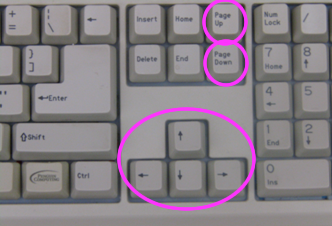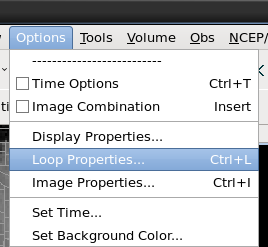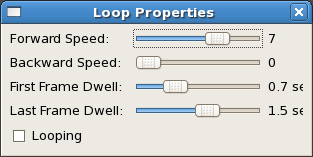Manually Toggling and Looping Single Elevation Angle Products in Time - OCLO
- 01- CAVE Fundamentals
- Setting the Time Match Basis of a Product
- Loading and Toggling Radar Graphic Overlay Products
- Overlaying CAPE on a Base Reflectivity Product
- Overlaying a Surface Plot on a Base Reflectivity Product
- Overlaying Model Image on Radar and Satellite
- Transferring Screen Products Between the Main Display Pane and Side Panes
- Loading, Arranging, Renaming, and Unloading Additional Map Editors
- Zooming In or Out of a Product View
- Panning a Zoomed-In Image in the Main Display Panel
- Switching the Color Table for a Radar Image Product
- Editing the Current Color Table
- Unload a Map Overlay
- Loading a Map Overlay
- Changing a Map's Display Characteristics
- Loading the Alphanumeric Information for a VWP Product
- Using the AFOS Browser to Load an Area Forecast Discussion
- Move and Adjust Width of AlertViz
- Launch Text Section Log and Display Detailed View
- Loading and Using the AWIPS Data Monitor
- Blinking a Range of Data Values
- Printing the Contents of the Main Display Panel
- Creating a Screen Capture of the Main Display Panel
- Saving/Loading Editor and Perspective Displays
- 02- D2D Fundamentals
- Create a New Procedure
- Opening an Existing Procedure
- Load a Product from the Product Inventory
- Clearing a Product from the Main Display Panel
- Manually Toggling and Looping Single Elevation Angle Products in Time
- Create an Image Combination and Toggle Between the Images
- Use Panel Combo Rotate and All Panel Sample on Dual Pol
- 03- D2D Radar
- Load Radar Products for Single Radar and Radar/MRMS Mosaics
- Toggling Product Displays
- Viewing Radar Cursor Readout Information
- Loading Products into Four-Panel Displays
- Submit an OTR for a Three Hour Precip (THP) Product
- Build a New Request in the RMR GUI
- Managing Active Requests in the RMR GUI
- Loading an All Tilts Product into the Main Display Panel
- Load a VWP Hodograph
- Load a Vertical Reflectivity Cross-Section Image Product Using the Volume Browser
- Load a Horizontal Reflectivity Cross-Section Image Product Using the Volume Browser
- 04- D2D Satellite
- 05- D2D Upper Air
- Load NSHARP into your CAVE Display
- Change NSHARP Configurations
- Cycling Through the Tables
- Toggling Display Insets
- Toggling Graphs and Statistics
- Interact with the Inventory in the D2D Skewt Standard Screen Configuration and Use Keyboard Shortcuts
- Configuring a Sounding and Hodograph Display
- Changing the Parcel Lifting Method
- Display Multiple Active Soundings
- 06- D2D Tools
- 07- D2D Applications
- Issue A New Severe Thunderstorm Warning
- Follow Up a Severe Thunderstorm Warning with a Severe Weather Statement
- Loading an FFMP Basin Trend Graph and Downstream Basin Trace
- Assessing QPE, Ratio, and Diff
- Closing the FFMP Table
- Loading the FFMP Basin Table
- Loading a SCAN Storm Cells Table
- Interacting with the SCAN Storm Cells Table
- Launching the MESO and TVS Tables
- Closing the SCAN Cell Table
Purpose:
This task will discuss the different ways that you can examine the different frames of an image or graphic product loop loaded in the main display panel.Tasks:
Assumptions:
- You will need to have loaded a product with a frame count of more than one.
- Toggle backward in time using one of the following methods:
- Method 1: Left-click on the “<” button in the tool bar.
- Method 2: Use the LEFT-ARROW keyboard shortcut.

- Toggle forward in time using one of the following methods:
- Method 1: Left-click on the “>” button in the tool bar.
- Method 2: Use the RIGHT-ARROW keyboard shortcut.
- Going to the first frame in the loop using one of the following methods:
- Method 1: Left-click on the “<<” button in the tool bar.
- Method 2: Use the keyboard shortcut <CTRL> + LEFT-ARROW.
- Going to the last frame in the loop using one of the following methods:
- Method 1: Left-click on the “>>” button in the tool bar.
- Method 2: Use the keyboard shortcut <CTRL> + RIGHT-ARROW.
- Toggle Looping using one of the following methods:
- Method 1: Left-click on the Toggle Looping button from the toolbar.
- This method works only to toggle loops on and off.
- Method 2: Use the keyboard shortcuts <Page Up> or <Page Down>.
- Press the <Page Up> button to toggle the loop on.
- Press the <Page Up> and <Page Down> buttons to speed up and slow down the loop, respectively.
- NOTE: When using the <Page Down> button to slow the loop, if the button is pressed enough times to where the Forward Speed = 0, then the loop will stop playing. Pressing the <Page Up> button will reactivate the loop at a Forward Speed = 1.
- Press the right or left arrow keys on the keyboard to stop the loop.
- Method 1: Left-click on the Toggle Looping button from the toolbar.
- Opening the Loop Properties GUI using one of the following methods:
- Method 1: From the Options menu, select Loop Properties.

- Method 2: Use the keyboard shortcut <CTRL> + L.
- Method 3: Left-click on the Loop Controls button in the toolbar.

- Method 1: From the Options menu, select Loop Properties.
- Adjusting Loop Properties GUI values using one of the following methods:
- Method 1: Drag the slider bars for the different parameters using the mouse.
- Method 2: Use the arrow keys on the keyboard. Left click on the slider bar corresponding to a parameter and use the arrow keys to increase/decrease parameter value.

- Use the keyboard shortcuts <Tab> and <SHIFT> + <Tab> to toggle between the different slider bars.
- If you were to toggle beyond the first or last items in the GUI (“Forward Speed” and “Looping”), then the thin black rectangle that focus on the property will disappear. You will have to repeat Step 7.2.1 to recover the focus rectangle.
- Use the keyboard shortcuts <Tab> and <SHIFT> + <Tab> to toggle between the different slider bars.
- Task Complete!



